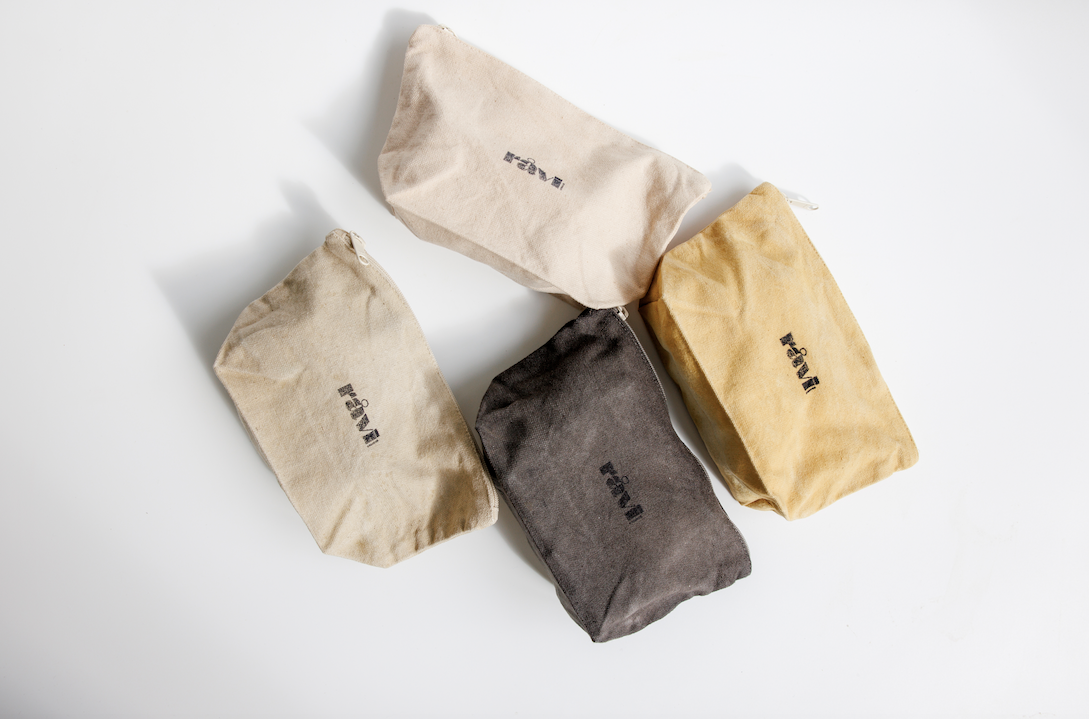
Atelier de Myri & the art of plant-dye
Interview: Catherine (råvi organics) and Miriam (Atelier de Myri)
When launching our new organic, Swiss-made face and hair oils, I wanted to celebrate the purity and power of plants not only in the formulas but also visually. That’s when the idea came to dye our cosmetic pouches, gua sha bags, and silk scrunchies with the very plants found in the oils. I reached out to Miriam from Atelier de Myri in Basel, who plant-dyes textiles by hand with a deep passion for nature’s colours and secrets - and she said yes! It felt like the perfect collaboration, uniting our shared love for plants and their incredible power.
 Catherine: Can you tell me a bit about your background? What did you do before working with plant-based dyes?
Catherine: Can you tell me a bit about your background? What did you do before working with plant-based dyes?
Miriam: I studied textile design at the Lucerne University of Applied Sciences and Arts, focusing primarily on screen printing and knitting. After graduation, I became increasingly interested in dyeing techniques and various resist methods, though I had always felt a strong connection to plants. Even during my studies, color was a central topic for me because of its significant environmental impact in the textile industry. Driven by the goal of contributing to a more sustainable textile industry, I delved deeper into dyes and textile dyeing processes, exploring different groups of colorants, including natural dyes. Over time, this path led me from conventional dyeing to natural dyeing and refinement techniques. For several years now, I have been deeply immersed in textile finishing using plant- and animal-based raw materials, as well as the creation of colours from natural sources.
Catherine: How did you first come into contact with natural dyeing, and what fascinated you about it?
Miriam: My very first encounter was during my studies, in a cross-institute module where I explored local plants and their potential for textile finishing. After graduating, I returned to this fascination. What captivated me most, besides working with plants, was the depth and vibrancy of the colours. They are incomparable to synthetic ones and create truly unique, unrepeatable pieces. So many factors can influence a natural material, its pigments, and the final dyeing process. The plant itself plays a role in the outcome, and my control only goes so far. I actually value this lack of full control—it feels like a meaningful dialogue with the very ground we live on. At the same time, I love the element of surprise that working with natural materials always brings.
Catherine: Was there a particular moment, project, or encounter that sparked your passion for this work?
Miriam: The summer before last, I received support for a project called Flora Alpina, where I studied the pigments of alpine meadows. I examined nearly 140 plants—from inconspicuous grasses to delicate blossoms. It might sound a little crazy, but I was fascinated by the colours hidden in even the most unassuming plants. Over time, you start to sense what might emerge, yet there are always surprises. The diversity and unexpectedness of the results deepened my fascination with working with plants and natural materials even further.
Catherine: Where do you find your inspiration when selecting plants or creating designs with natural dyes?
Miriam: I love going for walks, and I think that’s the most inspiring time for me. I observe my surroundings and take in patterns, colours, and moods.
Catherine: What fascinates you most about working with plant-based dyes?
Miriam: You never have complete control—you work with nature’s diversity. And in return, you get a truly unique piece every time.
Catherine: Do you have a favourite plant or dye? What makes it special for you—the color, the story, the scent, or something else?
Miriam: I don’t have a single favourite plant or dye. There are many that I find fascinating because of their history—through them, we gain a deeper understanding of how colour choices have shaped fashion, painting, and even architecture.
Catherine: How do the seasons or your surroundings influence your work and color palette?
Miriam: The seasons certainly have an impact. In winter, the variety of available plants isn’t the same as in summer. Even so, there are always natural materials that can be used for dyeing. It’s fascinating to see how the colours shift with the seasons—not so much in hue, but in intensity. I also enjoy adapting to the rhythm of the year: from spring to autumn, I focus more on dyeing, while winter is a time for other tasks.
Catherine: Have there been any particular challenges when working with these special plants for our collab?
Miriam: Every dye and every fiber reacts differently. As I mentioned, there are many factors that can influence natural dyeing—even something as simple as the water. For me, the greatest challenge is always working with fibers I haven’t used before. I don’t mean the type of fiber itself, but rather how it’s produced and processed, which can vary greatly, as well as the thickness of the yarn or the density of the fabric. This means I can make only educated guesses about the outcome, without ever being certain.
Catherine: What did you particularly enjoy about this project, diving deeper into the plants used in the organic face and hair oil?
Miriam: I loved exploring which colours could be achieved using the ingredients from råvi organics. I especially enjoy the research process. It’s also always a great joy to be part of a project with someone who puts time and thought into creating a good and considerate product.
Catherine: Thank you so much for the inspiring collaboration. It was amazing to see such beautiful colours emerge from the ingredients in the oils! How did you experience the collab with råvi organics ?
Miriam: I found the collaboration to be excellent. I loved your idea from the very beginning, and everything went smoothly and harmoniously. I don’t think it could have gone any better. I sincerely thank you for the opportunity and the collaboration, and I’m delighted to see your wonderful products wrapped in the beautiful colours of their ingredients.
Catherine: If all resources were available to you, what would your dream project in plant dyeing look like?
Miriam: I don’t have one specific dream project, but what I really enjoy—and hope for in my future work—are collaborations like this one. Someone brings an idea or a request, and I explore what’s possible and how we can make it happen. These projects always bring new challenges, help me grow, and keep my work alive. This kind of collaboration allows me to apply my knowledge of natural dyeing techniques in different contexts while learning from others at the same time.


